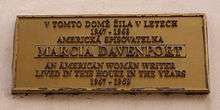Marcia Davenport
Marcia Davenport (June 9, 1903 – January 16, 1996) was an American author and music critic.
Biography
Marcia Davenport was born Marcia Glick in New York City on June 9, 1903, the daughter of Bernard Glick and the opera singer Alma Gluck, and she became the stepdaughter of violinist Efrem Zimbalist when Alma Gluck remarried.
Davenport traveled extensively with her parents and was educated intermittently at the Friends School in Philadelphia, Pennsylvania, and the Shipley School in Bryn Mawr. She began at Wellesley College but eloped to Pittsburgh in April 1923 and married Frank D. Clarke. Eventually she earned her B.A. at the University of Grenoble. Her first child, Patricia Delmas Clarke, was born in 1924, but in 1925 she divorced Clarke.
She took an advertising copywriting job to support herself and her daughter. In 1928 she began her writing career on the editorial staff of The New Yorker, where she worked until 1931. On May 13, 1929, she married Russell Davenport, who soon after became editor of Fortune. Davenport's second daughter was born in 1934. That same year she began as the music critic of Stage magazine. Davenport had close ties through her mother and stepfather to the classical music world and particularly to the opera world of Europe and America in the first half of the 20th century. She was first celebrated as a writer for her first book, Mozart, the first published American biography of composer Wolfgang Amadeus Mozart. Her marriage to Russell Davenport ended in 1944.
Novels and memoir

She also wrote several popular novels, notably The Valley of Decision, a saga which traces the Scott family, prototypical owners of an iron works in Pittsburgh, from 1873 to the events of World War II. Davenport lived in Pittsburgh shortly after her first marriage, later using that background, along with further research on the steel industry, for the 788-page bestseller.
Her memoir Too Strong for Fantasy (1967) describes the people, the music, the places and the political forces which shaped her life. Of particular interest is her telling of the events leading up to the death of the Czech diplomat and foreign minister Jan Masaryk in the Czernin Palace in Prague in 1948 and of her close relationship with Masaryk over many years.
Films
Two of Davenport's novels were made into films, both released by Metro-Goldwyn-Mayer: The Valley of Decision and East Side, West Side. The Valley of Decision starred Greer Garson, Gregory Peck, Donald Crisp, Lionel Barrymore, Preston Foster, Marsha Hunt, Gladys Cooper, Reginald Owen, Dan Duryea and Jessica Tandy. The film was nominated for Academy Awards for Best Actress in a Leading Role (Greer Garson) and Best Music, Scoring of a Dramatic or Comedy Picture. East Side, West Side starred James Mason, Barbara Stanwyck, Van Heflin, and Ava Gardner.
My Brother's Keeper (1954), based on the Collyer brothers, was optioned for films to various individuals over decades, but no film was ever produced.
Radio
In the 1930s, she was a regular commentator on the radio broadcasts of the Metropolitan Opera, though she appeared infrequently in subsequent decades, with her final Met broadcast being in 1966. During the 1940s, she was heard on various radio panel discussion shows, and she was a panelist with Alexander Woollcott and Rex Stout on The People's Platform program of January 23, 1943, when Woollcott had a heart attack during the broadcast and died before he arrived at Roosevelt Hospital.
In 1967, she appeared on the NBC radio program Toscanini: The Man Behind the Legend, paying tribute to the legendary Italian conductor Arturo Toscanini (1867–1957).
Marcia Davenport died January 16, 1996, in Monterey, California, at the age of 92. She was survived by her youngest daughter Cornelia Davenport Schwartz, six grandchildren, and seven great-grandchildren. Her eldest daughter Patricia Clarke Kapplow, who predeceased her, was the mother of four of Marcia Davenport's grandchildren.
There is a memorial plaque dedicated to Marcia Davenport in Nerudova Street, Prague.
Works
- Mozart, a biography (New York: Scribner, 1932)
- Of Lena Geyer, a novel (New York: Scribner, 1936)
- The Valley of Decision, a novel (New York: Scribner, 1942)
- East Side, West Side, a novel (New York: Scribner, 1947)
- My Brother's Keeper, a novel (New York: Scribner, 1954)
- Garibaldi: Father of Modern Italy, a juvenile biography (New York: Random House, 1956)
- The Constant Image, a novel (New York: Scribner, 1960)
- Too Strong for Fantasy, an autobiography (New York: Scribner, 1967)
- Jan Masaryk: Posledni Portret, a memoir (Czechoslovakia: 1990)
References
Sources
- Davenport, Marcia (1993). Too Strong for Fantasy. Pittsburgh: University of Pittsburgh Press. ISBN 0-8229-5909-7.